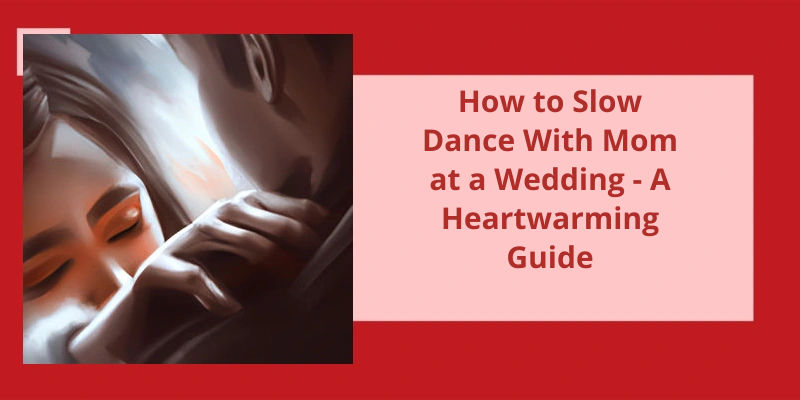A wedding is often regarded as one of the most special days in anyone's life, but it's even more special when it's your own child getting married. It's a beautiful moment where emotions run high, and tears of joy flow freely. As the mother of the bride or groom, this day is just as important for you as it’s for the bride or groom. The dance floor is a place where memories are created and cherished for years to come, and the mother-son or mother-daughter dance is no exception. However, not everyone knows how to slow dance, and it can be even more daunting to do so with your own child. In this article, we will be talking about some tips and tricks on how to slow dance with your mom at a wedding, and how to make it a special moment for both of you.
How Long Should Mother Groom Dance Last?
When it comes to planning your wedding, it’s important to consider every aspect of the day, including how long certain events will take. One of the most special moments is the mother groom dance. However, it’s important to keep in mind that this dance shouldn’t overshadow the first dance between you and your spouse.
A good guideline for how long the mother groom dance should last is between a minute and a half to three minutes. This gives enough time for the dance to feel special without dragging on for too long. However, it’s ultimately up to the couple and their families to decide what feels right for them.
When choosing a song for the mother groom dance, it’s important to consider the lyrics and how they resonate with you and your family. It’s also important to choose a song that’s easy to dance to and sets the right tone for the moment. The length of the song should also be taken into consideration when deciding on the length of the dance.
It’s also important to practice the dance beforehand to ensure that it goes smoothly on the wedding day. This won’t only give you and your mother a chance to bond but also help prevent any mishaps on the dance floor. Practicing the dance can also help you both feel more comfortable and confident during the dance itself.
As long as it doesn’t overshadow the first dance and is a reasonable length, the dance can be a beautiful and emotional moment to cherish for years to come. Whether it lasts for a minute and a half or three minutes, the most important thing is that it feels right for you and your loved ones.
As wedding ceremonies have become more personalized, so have the traditions associated with them. One such tradition is the parent dance, which involves the bride and groom dancing with their respective parents. While these dances are a common feature of most weddings, there’s often confusion over when they should take place and who should be involved. In this article, we will explore the many different ways in which parent dances can be incorporated into a wedding celebration, and answer some of the most frequently asked questions about this cherished tradition.
Do the Parents of the Bride Dance?
The tradition of parent dances at a wedding reception is a long-standing one that’s been cherished by many families for generations. These dances not only provide an opportunity for the bride and groom to honor their parents, but they also add a special touch of sentimentality to an already emotional day. Whether it’s the father-daughter dance or the mother-son dance, these moments are ones that will be remembered by all who attend.
While it may seem like a small detail, the timing of the parent dances can play a big role in the overall flow of the reception. Some couples opt to have these dances immediately following the first dance, which can be a sweet way to transition into the festivities. However, others prefer to save them for later in the evening, perhaps after dinner, when the energy is higher and the party is in full swing.
No matter how the dances are orchestrated, they provide a beautiful opportunity for parents and their children to share a tender moment together.
Source: Here’s the Exact Order of Dances at a Wedding Reception
Weddings are one of the most special moments in a person’s life, and couples always strive to make the occasion as memorable as possible. While traditional dances like the father-daughter and mother-son dances remain popular, some couples now prefer to add a unique twist to their celebration with a mother-daughter dance. In this article, we will take a closer look at what a mother-daughter dance entails, how it works, and everything else you need to know to make it happen.
Can I Do a Mother Daughter Dance at My Wedding?
It’s becoming more and more popular for mothers and daughters to share a dance at weddings. This can be a special moment for both the mother and daughter, as well as a meaningful way to share the wedding experience together.
There are many variations on the mother-daughter dance. Some brides choose to do a traditional dance with their mothers, while others prefer to choose a song that’s special to both of them and choreograph a unique routine.
One of the benefits of having a mother-daughter dance is that it can help to include both mothers and fathers in the festivities. While the father-daughter dance and mother-son dance are lovely and important, they can leave some guests feeling left out.
It can be a classic love song or something more upbeat – the choice is entirely up to the bride and her mother.
How to Involve Other Family Members in the Mother-Daughter Dance.
Here are some simple ways to encourage other family members to participate in the mother-daughter dance: invite them to participate, let them know how important it’s to you, choose a song that everyone enjoys, and offer to practice with them before the big day. By including the whole family in this special moment, you can create cherished memories that will last a lifetime.
Traditionally, weddings are known for their joyful atmosphere and dancing is an essential part of it. Dancing isn’t only a way of expressing happiness but also a sign of involvement and celebration at the event. While dancing, people come together to enjoy the moment and make memories that last a lifetime. However, not everyone knows who’s supposed to dance at a wedding or how to go about it. In this article, we will explore the traditions and etiquettes surrounding wedding dances, helping you navigate your way through the festivities with ease.
Who Is Supposed to Dance at a Wedding?
However, the traditions and expectations surrounding wedding dances can vary greatly depending on the culture and region. In some cultures, the entire wedding party dances together in a coordinated routine, while in others, only close family members participate in the formal dances. It’s important to consider the wishes of the bride and groom when planning the dance portion of a wedding.
It’s important to think carefully about what kind of atmosphere they want to create and to make sure that everyone feels comfortable and included in the festivities. Whether it’s a traditional formal dance or a wild and crazy night on the dance floor, the most important thing is that everyone has a good time celebrating the happy couple.
The History of Wedding Dances and How They Have Evolved Over Time
- Wedding dances date back to ancient times.
- During medieval times, newlyweds would perform a slow dance called the pavane.
- In the 17th century, ballroom dancing became popular at weddings.
- The waltz became a popular wedding dance in the 19th century.
- In the 20th century, swing dancing and the cha-cha became popular wedding dances.
- More recently, couples have opted for unique dances such as salsa, tango, and even hip-hop.
Moving on from the basics of slow dancing, there are a few more steps and techniques that can elevate your slow dancing skills. Whether you’re preparing for a special event or just want to impress your partner, learning how to slow dance can be a fun and rewarding experience.
Is It Easy to Slow Dance?
To make it even easier, it’s a good idea to have a partner who’s taller or shorter than you, as this can make it easier to find a comfortable position. You can also try closing your eyes and focusing on the rhythm of the music to help you relax and move with the beat.
One of the challenges of slow dancing is getting the timing right. You need to make sure that both you and your partner are moving at the same pace, and that you’re both comfortable with the speed of the dance. Some people find it helpful to count out the beats of the music in their head, while others prefer to listen to the melody and let the music guide them.
One of the best things about slow dancing is that it can be adapted to suit any style of music. Whether you prefer classic ballads, jazz standards, or modern pop songs, there’s sure to be a slow dance that fits the bill. You can experiment with different types of music and see which ones feel most natural and enjoyable for you.
If youre feeling nervous about trying slow dancing for the first time, remember that it’s all about having fun and enjoying the moment. Dont worry too much about getting every step and move perfect – as long as youre both moving together and enjoying the music, thats all that matters. With a little practice and patience, you can become a confident and skilled slow dancer in no time!
Different Types of Slow Dances (e.g. Waltz, Foxtrot, Rumba)
- Waltz
- Foxtrot
- Rumba
- Tango
- Cha Cha
- Swing
- Bachata
Mastering slow dance steps is a fundamental part of enjoying ballroom dancing. Whether you’re dancing with a partner or in a group, understanding the basics of slow dance moves can help you get started. But before we delve into the steps, there’s an important question that needs to be answered: Is slow dance left or right? Once we’ve that sorted out, we can proceed to learn the basic steps.
Is Slow Dance Left or Right?
Slow dance is a popular genre of dance that can be enjoyed by couples at any level of dance expertise. Unlike other genres of dance, slow dance doesn’t have a specific direction that needs to be followed. Couples can move in any direction they wish, as long as their steps are in line with the beat of the music.
While the basic steps of slow dance may vary slightly depending on the type of dance, they generally consist of the man placing his right hand on the womans hip and the woman placing her left hand on her partners shoulder. The couple then moves together in rhythm to the music, performing various dance moves in a slow, romantic manner.
It’s important to note that slow dance can be danced by any gender, not just between male and female partners. When two females are dancing together for learning purposes, determine who’ll lead.
It’s a style of dance that’s very intimate and romantic, allowing two people to connect on a deep level.
Slow Dance Basics for Beginners
This article will teach beginners the basics of slow dancing. You’ll learn about posture, footwork, and how to connect with your partner. By the end, you should feel confident enough to hit the dance floor and enjoy a slow dance.
Conclusion
It’s a moment of deep connection and love, and it shouldn't be taken for granted. To make the most of this special moment, take the time to prepare yourself emotionally and physically, and practice your dance moves with your mom to ensure that you’re both comfortable and confident on the dance floor. Remember to be present in the moment and enjoy this beautiful experience with the most important woman in your life.






